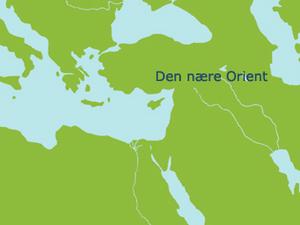
The Far East – the Cradle of Civilization
The lands along the eastern Mediterranean Sea and farther to the east have at all times been civilization’s proving grounds, in addition to being the meeting place of East and West and a hotbed of political turmoil. It is the birthplace of some of the most significant advancements in humankind’s history, which have also determined the development of Denmark: agriculture, writing, and complex forms of social organization.
The “Agricultural Revolution” began around 8000 BCE in the “Fertile Crescent”, which stretches from ancient Palestine and Syria along southeastern Turkey to the northern section of the Zagros Mountains in Iran. Cities developed in the 4th millennium BCE in Mesopotamia, that part of modern Iraq and Syria between the two major rivers of the region, the Tigris and the Euphrates. Experiments with writing began towards the end of this period.
The societies of the region closely affected each other, and boundaries were in constant movement. During the Bronze Age, ca. 3000-1200 BCE, social organization became more complex and larger cities developed, filled with temples and palaces, and connected to far-reaching trading systems.
New states and empires appeared in the Iron Age, ca. 1200-330 BCE. The first great empire of this period to rule most of the ancient Near East was that of the Assyrians; the last was the even more impressive empire of the Achaemenid Persians. The Persian Empire was conquered by Alexander the Great (356-323 BCE), and the Near East was dominated by the Macedonian-Greeks until Rome enveloped much of it in the century before the birth of Christ. Christianity spread throughout the region until the emergence of Islam in the 7th century CE.
